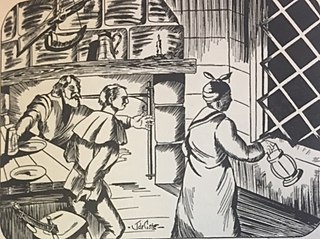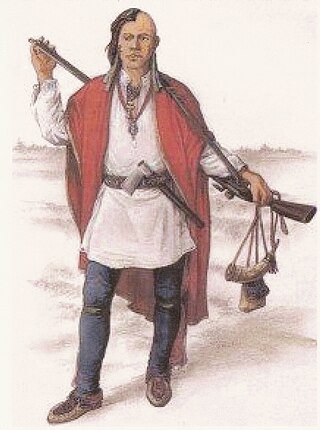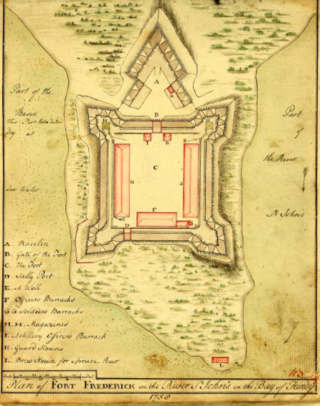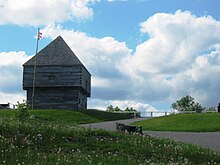
The Battle of Fort Cumberland was an attempt by a small number of militia commanded by Jonathan Eddy to bring the American Revolutionary War to Nova Scotia in late 1776. With minimal logistical support from Massachusetts and four to five hundred volunteer militia and Natives, Eddy attempted to besiege and storm Fort Cumberland in central Nova Scotia in November 1776.

The 84th Regiment of Foot (Royal Highland Emigrants) was a British regiment in the American Revolutionary War that was raised to defend present day Ontario, Quebec and Atlantic Canada from the constant land and sea attacks by American Revolutionaries. The 84th Regiment was also involved in offensive action in the Thirteen Colonies; including North Carolina, South Carolina, Georgia, Virginia and what is now Maine, as well as raids upon Lake Champlain and the Mohawk Valley. The regiment consisted of 2,000 men in twenty companies. The 84th Regiment was raised from Scottish soldiers who had served in the Seven Years' War and stayed in North America. As a result, the 84th Regiment had one of the oldest and most experienced officer corps of any regiment in North America. The Scottish Highland regiments were a key element of the British Army in the American Revolution. The 84th Regiment was clothed, armed and accoutred the same as the Black Watch, with Lieutenant Colonel Allan Maclean commanding the first battalion and Major General John Small of Strathardle commanding the second. The two Battalions operated independently of each other and saw little action together.
Colonel John Allan M.P. J.P. was a Canadian politician who became an officer with the Massachusetts Militia in the American Revolutionary War. He served under George Washington during the Revolutionary War as Superintendent of the Eastern Indians and Colonel of Infantry, and he recruited Indian tribes of Eastern Maine to stand with the Americans during the war and participated in border negotiations between Maine, and New Brunswick.

The history of New Brunswick covers the period from the arrival of the Paleo-Indians thousands of years ago to the present day. Prior to European colonization, the lands encompassing present-day New Brunswick were inhabited for millennia by the several First Nations groups, most notably the Maliseet, Mi'kmaq, and the Passamaquoddy.

The history of Nova Scotia covers a period from thousands of years ago to the present day. Prior to European colonization, the lands encompassing present-day Nova Scotia were inhabited by the Mi'kmaq people. During the first 150 years of European settlement, the region was claimed by France and a colony formed, primarily made up of Catholic Acadians and Mi'kmaq. This time period involved six wars in which the Mi'kmaq along with the French and some Acadians resisted the British invasion of the region: the French and Indian Wars, Father Rale's War and Father Le Loutre's War. During Father Le Loutre's War, the capital was moved from Annapolis Royal, Nova Scotia, to the newly established Halifax, Nova Scotia (1749). The warfare ended with the Burying the Hatchet ceremony (1761). After the colonial wars, New England Planters and Foreign Protestants immigrated to Nova Scotia. After the American Revolution, Loyalists immigrated to the colony. During the nineteenth century, Nova Scotia became self-governing in 1848 and joined the Canadian Confederation in 1867.

Jonathan Eddy was a British-American soldier, who fought for the British in the French and Indian War and for the Americans in the American Revolution. After the French and Indian War, he settled in Nova Scotia as a New England Planter, becoming a member of the General Assembly of Nova Scotia. During the American Revolutionary War, he was strongly supportive of the rebellion against the Crown. He encouraged the residents of Nova Scotia to join in open revolt against King George III and England. He led a failed attempt to capture Fort Cumberland in 1776 and was forced to retreat to Massachusetts, the place of his birth. The following year, he led the defense of Machias, Maine during the Battle of Machias (1777). After the war, he established the community now known as Eddington, Maine in 1784, where he died.
Maugerville is a New Brunswick unincorporated community located on the east bank of the Saint John River in Maugerville Parish, Sunbury County, in the Canadian province of New Brunswick. The settlement is located on provincial Route 105, 16 kilometres southeast of the capital city of Fredericton and 3.18 kilometres northeast of the town of Oromocto.

The St. John River campaign occurred during the French and Indian War when Colonel Robert Monckton led a force of 1150 British soldiers to destroy the Acadian settlements along the banks of the Saint John River until they reached the largest village of Sainte-Anne des Pays-Bas in February 1759. Monckton was accompanied by Captain George Scott as well as New England Rangers led by Joseph Goreham, Captain Benoni Danks, as well as William Stark and Moses Hazen, both of Rogers' Rangers.

The Battle of Machias was an amphibious assault on the Massachusetts town of Machias by British forces during the American Revolutionary War. Local militia aided by Indian allies successfully prevented British troops from landing. The raid, led by Commodore Sir George Collier, was executed in an attempt to head off a planned second assault on Fort Cumberland, which had been besieged in November 1776. The British forces landed below Machias, seized a ship, and raided a storehouse.

Fort Menagoueche was a French fort at the mouth of the St. John River, New Brunswick, Canada. French Officer Charles Deschamps de Boishébert et de Raffetot and Ignace-Philippe Aubert de Gaspé built the fort during Father Le Loutre's War and eventually burned it themselves as the French retreated after losing the Battle of Beausejour. It was reconstructed as Fort Frederick by the British.

Fort Howe was a British fort built in Saint John, New Brunswick during the American Revolution. It was erected shortly after the American siege in 1777 to protect the city from further American raids. The 18th and 19th century British Army fortification stood at the mouth of the Saint John River where it empties into the Bay of Fundy. A replica blockhouse has been constructed approximately 250 metres to the northeast of the original structure.
The Royal Fencible American Regiment of Foot was a Loyalist battalion of infantry raised in 1775 to defend British interests in the colony of Nova Scotia. The RFA was commanded by Lt. Col. Joseph Goreham throughout its existence. The most notable achievement of the RFA was the successful defense of Fort Cumberland during the Eddy Rebellion in November, 1776, which prevented the revolution in the other American colonies from moving into Nova Scotia.

Nova Scotia is a Canadian province located in Canada's Maritimes. The region was initially occupied by Mi'kmaq. The colonial history of Nova Scotia includes the present-day Maritime Provinces and the northern part of Maine, all of which were at one time part of Nova Scotia. In 1763, Cape Breton Island and St. John's Island became part of Nova Scotia. In 1769, St. John's Island became a separate colony. Nova Scotia included present-day New Brunswick until that province was established in 1784. During the first 150 years of European settlement, the colony was primarily made up of Catholic Acadians, Maliseet, and Mi'kmaq. During the last 75 years of this time period, there were six colonial wars that took place in Nova Scotia. After agreeing to several peace treaties, the long period of warfare ended with the Halifax Treaties (1761) and two years later, when the British defeated the French in North America (1763). During those wars, the Acadians, Mi'kmaq and Maliseet from the region fought to protect the border of Acadia from New England. They fought the war on two fronts: the southern border of Acadia, which New France defined as the Kennebec River in southern Maine, and in Nova Scotia, which involved preventing New Englanders from taking the capital of Acadia, Port Royal and establishing themselves at Canso.

The history of Saint John, New Brunswick is one that extends back thousands of years, with the area being inhabited by the Maliseet and Miꞌkmaq First Nations prior to the arrival of European colonists. During the 17th century, a French settlement was established in Saint John. During the Acadian Civil War, Saint John served as the seat for the administration under Charles de Saint-Étienne de la Tour. The French position in Saint John was abandoned in 1755, with British forces taking over the area shortly afterwards.

The military history of the Mi'kmaq consisted primarily of Mi'kmaq warriors (smáknisk) who participated in wars against the English independently as well as in coordination with the Acadian militia and French royal forces. The Mi'kmaq militias remained an effective force for over 75 years before the Halifax Treaties were signed (1760–1761). In the nineteenth century, the Mi'kmaq "boasted" that, in their contest with the British, the Mi'kmaq "killed more men than they lost". In 1753, Charles Morris stated that the Mi'kmaq have the advantage of "no settlement or place of abode, but wandering from place to place in unknown and, therefore, inaccessible woods, is so great that it has hitherto rendered all attempts to surprise them ineffectual". Leadership on both sides of the conflict employed standard colonial warfare, which included scalping non-combatants. After some engagements against the British during the American Revolutionary War, the militias were dormant throughout the nineteenth century, while the Mi'kmaq people used diplomatic efforts to have the local authorities honour the treaties. After confederation, Mi'kmaq warriors eventually joined Canada's war efforts in World War I and World War II. The most well-known colonial leaders of these militias were Chief (Sakamaw) Jean-Baptiste Cope and Chief Étienne Bâtard.

The Maliseet militia was made up of warriors from the Maliseet of northeastern North America. Along with the Wabanaki Confederacy, the French and Acadian militia, the Maliseet fought the British through six wars over a period of 75 years. They also mobilized against the British in the American Revolution. After confederation, Maliseet warriors eventually joined Canada's war efforts in World War I and World War II.

Fort Frederick was a British fort at what is now Saint John, New Brunswick, Canada. It was built during the St. John River Campaign of the French and Indian War. It was one of three significant forts which the British built on the major rivers in the Northeast to cut off the natives' water way to the ocean to prevent attacks on the British settlers.
Nathaniel Reynolds was a shoemaker, army captain and privateer during the American Revolutionary War. He was the captain of the Blackbird.

The Raid on Saint John took place on 27 August 1775 during the American Revolutionary War. The raid involved American privateers from Machias, Massachusetts Bay attacking Saint John, Nova Scotia. The privateers intended to stop the export of supplies being sent to the loyalists in Boston. This raid was the first hostile act committed against Nova Scotia and it resulted in raising the militia across the colony.

The Province of Nova Scotia was heavily involved in the American Revolutionary War (1776–1783). At that time, Nova Scotia also included present-day New Brunswick until that colony was created in 1784. The Revolution had a significant impact on shaping Nova Scotia, "almost the 14th American Colony". At the beginning, there was ambivalence in Nova Scotia over whether the colony should join the Americans in the war against Britain. Largely as a result of American privateer raids on Nova Scotia villages, as the war continued, the population of Nova Scotia solidified their support for the British. Nova Scotians were also influenced to remain loyal to Britain by the presence of British military units, judicial prosecution by the Nova Scotia Governors and the efforts of Reverend Henry Alline.


















